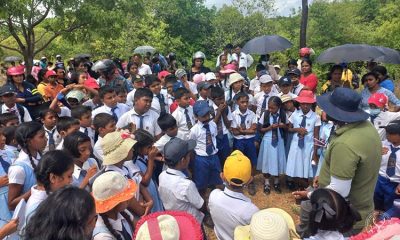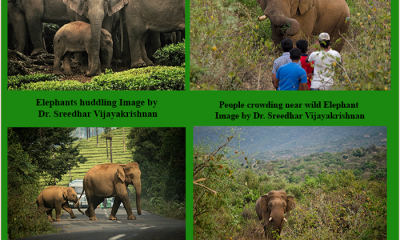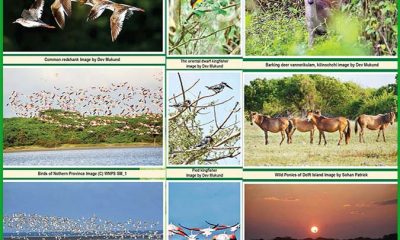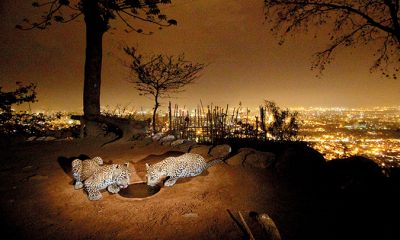Features
Hoffmann’s involvement in the WNPS and some unpleasant incidents in later years
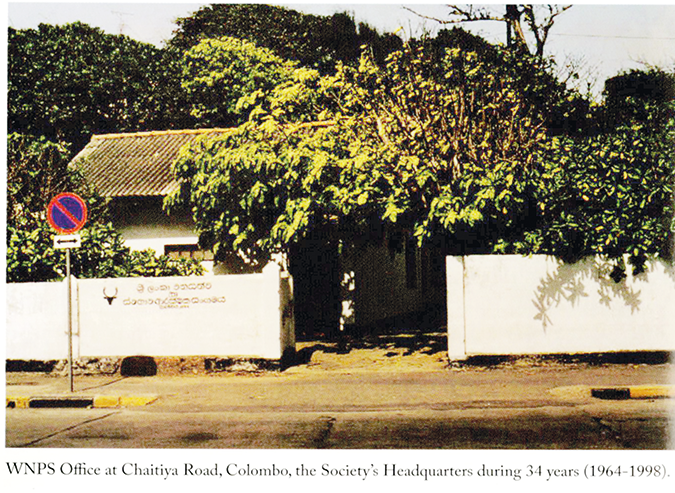
(Excerpted from the authorized biography of Thilo Hoffmann
by Douglas. B. Ranasinghe)
In the development of the Society Thilo received the loyal support of Sam Rajendran, who worked as Office Assistant until 1973. He knew most members personally, and was much liked, an asset to the Society. He was followed by J. Azeez, who worked in that position for many years, with integrity and wide acceptance. Many sound people of eminence were attracted to the General Committee, and other positions were filled by promising youngsters.
There were people such as Leela Dias-Bandaranayake, Chandra Liyanage, Nigel Austin, Charitha Ratwatte and “Ken” Balendra. Chari (C. P.) de Silva was Treasurer for many years. Lalith Senanayake, as the long-standing Honorary Secretary of the Society, was of great help to Thilo, and became a close friend. During the time of his leadership of the Society Thilo Hoffmann was a Director and later the CEO of A. Baur and Co. Ltd. The company provided the infrastructure for his conservation work, and helped the Society in many important ways.
Thilo’s secretary at Baurs, Mrs Yvonne Nadarajah, nee Rogers, most efficiently did all the typing of his innumerable letters, memos, reports, minutes and publications. These were usually dictated after office hours: see the Elapata article. She learned to take down in shorthand most complicated and technical texts. Thilo stresses that without her exceptional devotion and efficiency he would not have been able to achieve what he did.
There were some who claimed that the CEO of a firm which dealt in fertilizers and agrochemicals (amongst other things) could not possibly also be the head of the country’s premier conservation society. Thilo did not see it that way. He explains:
“The responsible use of fertilizers in agriculture worldwide is essential for the ability to feed growing populations and enhance the quality of life. Only the excessive, ill-informed use of fertilizers and chemicals causes environmental damage. Sensible and intelligent conservation has to be combined with realistic and responsible agricultural policies and practices, which on a large scale necessarily involve the use of chemicals.”
When Thilo started at Baurs their special mixtures consisted of up to 50% and more of organic ingredients, such as bone-meal, fish-meal, guano, oil-cakes etc. The prices of these had in the meantime risen to such heights that their use as fertilizers had long become prohibitive.
Alongside his work for the WNPS and conservation, he continued his explorations in the island, surveys of its natural sites and the study of its fauna and flora. This is reflected in various publications. In Loris for example, his personal observations of elephants over the years led him to write the two articles on their habitats, numbers and distribution.
We find that in the issue containing the first there is also by Hoffmann ‘’The Hog Deer’ and ‘The Cats of Sri Lanka’ and in the second: ‘Down the Mahaweli by Boat 114’ – a seven-page survey, much more than an account of adventure. He also pursued his interest in ornithology, and, in parallel with the WNPS, conducted the affairs of the Ceylon Bird Club, as described in a later Chapter.
TWO CRITICAL CHANGES
In 1966, when E. B. Wikramanayake was the President and Thilo was the Secretary, one of the stated objectives of the Society was “to safeguard the interests of legitimate sport”, that is, hunting. Hoffmann was largely responsible for removing that obnoxious clause. Wikramanayake, paying tribute to him on his election as Honorary Life Member in 1981, stated this among his many achievements on behalf of the Society.
It was a hard battle as hunters and their supporters were very strong in the Society. For the first time a poll was taken to ascertain the views of the entire membership. The deletion of the hunting clause was approved by majority vote. In a largely Buddhist country it is remarkable that this change was initiated by Thilo.
During his tenure as President of the Society, Hoffmann suggested that its name be changed from the ‘Wildlife Protection Society of Ceylon’ to the ‘Wildlife and Nature Protection Society of Ceylon’, in view of the fact that wildlife cannot be properly protected without conserving nature in general. This suggestion was given effect to at the Annual General Meeting held on December 14, 1971. The new name (now ending in “Sri Lanka”) is abbreviated `WNPS’.
At the same meeting a resolution to launch a campaign for the preservation of some 20,000 acres of Sinharaja was adopted. The rescue of this rainforest is the subject of the next Chapter. Hoffmann had argued also that without the change the Society would not be able to speak effectively in this matter.
Spreading the message
After the successful battle to save Sinharaja, it became apparent to the WNPS that the message of conservation should be taken to the grassroot level, the village. From time immemorial villagers knew the value of protecting the forest, as much as the wewa and temple. There is a belief among them that every large tree is the abode of a deity and the forest is sacred. When the necessity arose to cut a tree, they lit a lamp and obtained permission from the incumbent deity before it was felled. These old customs and traditions were gradually eroding.
The Rev. Neluwe Gunananda Thero, who helped in saving Sinharaja, met Thilo as President of the WNPS in his office, and made a request that the Society, as the only concerned organization in Sri Lanka, should endeavour to convey the conservation message to the rural population. A similar point had been made earlier by Dr R. L. Spittel, the first Ceylonese President of the Wildlife Protection Society of Ceylon, when in his biography ‘Surgeon of the Wilderness’, he declared:
“Conservation in this island is essentially for the people of Ceylon, and we should not for a moment forget this.” The same idea had been expressed many times by Thilo, both verbally and in writing. The General Committee of the Society appointed an Action Committee. Thilo obtained data from World Wildlife Fund India about the formation of Nature Clubs in schools.
The action committee submitted their proposals to take conservation to village communities through schools, and to publish the first nature magazine in Sinhala. In this manner knowledge of conservation could be imparted, and children encouraged to write about their experiences.
The proposals were approved and the first student Nature Club was declared open in 1976 at Kalutara Maha Vidyalaya, with the assistance of Nimal Liyanarachchi, a science teacher of the school. He had been a student of Douglas B. Ranasinghe, the Secretary of the Action Committee. Thilo Hoffmann, as President, and Ranjen Fernando, as Secretary, of the WNPS participated in this event, and a mango tree was planted in the school premises to commemorate it.
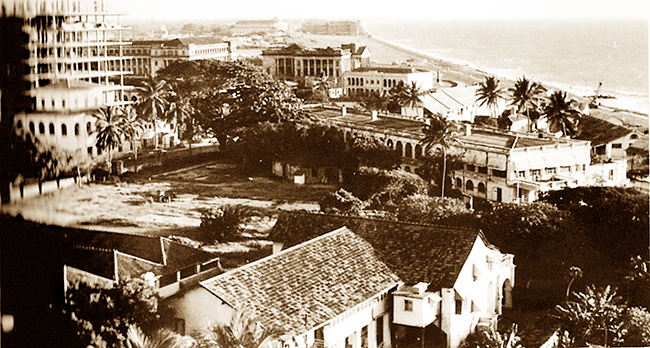
View from Baur’s Building, Colombo, towards Mount Lavinia (1960). At left rear, the new Ceylinco Building under construction, the old building in front of it. Foreground: Clippenberg House, empty space for the Central Bank with British military quarters (right extreme).
In the same year the Sinhala magazine Warana — translation: great tusker — was published, with Russell Kuruppu as editor and Ranasinghe as sub-editor. The concept was an instant success. By 1987 there were 80 Student Nature Clubs in various parts of the country, and from the inception the Department of Education purchased annually 6,400 copies of the biennial magazine for distribution to all government schools in the country. Warana, the first Sinhala nature periodical continues without a break, with Ranasinghe as editor, and has now attained 30 years of successful existence.
In order to further activate interest of school students especially and of all Sinhala- speaking people in birds and their environment, the WNPS in 1978 financed the first book on birds written in Sinhala, namely Asirimat Kurulu Lokaya by Douglas Ranasinghe, and also the Sri Lanka’ Avifaunal List by T. S.U. de Zylva and the same author, which presented the first list of Sinhala names of all the bird species known in Sri Lanka.
As a result of the pioneering action taken by the WNPS headed by Hoffmann, there are at present over 400 Student Nature Clubs in schools in Sri Lanka, and the past members of these have their own NGOs, to promote the conservation movement in urban areas as well as at village level. The patron teachers of the Student Nature Clubs, too, have their separate Patron Teachers Clubs, and a nature magazine, and quietly promote the conservation movement at village level.
In 1976 Hoffmann, as President of WNPS, wrote a handout titled Conserve or Perish, which was distributed throughout the country to schools, to farmers, to administrators and all people young and old. This was done in the hope that those who read the leaflet would look at their own environment, recognize the truths of warnings given in the address and act in a responsible manner for the good of all citizens and the country. 100,000 copies of this leaflet in Sinhala and 15,000 copies in English were printed and distributed.
Problems within
Thilo Hoffmann’s leadership had clearly brought the Society greater respect and influence. Yet there came a time when opposition to his Presidency began to make life difficult for him.It all started with a dispute with the World Wildlife Fund. Thilo tried to uphold the independence and dignity of the Sri Lankan national society against the overbearing attitude of the international giant and its representatives. One of the issues was Hoffmann’s opposition to a First-World ‘elephant expert’. This man proposed, among other things, that all or most wild elephants in Sri Lanka over seven feet tall should be killed.
The situation was used against Thilo by a young woman who had lately formed a dislike towards him. She thought, mistakenly, that the Hoffmanns were partly to blame for the breakdown of her marriage to a close friend and fellow office-bearer in the WNPS. A campaign of vilification against Thilo began to spread, through powerful family connections. It had strong xenophobic undertones: “Why do we need a foreigner as President of the WNPS?”
This was eagerly picked up by a motley range of people of all walks of life, most of whom did not know Thilo Hoffmann, or what he stood for, and also by some with personal grudges. Others who had never before or after shown even the vaguest interest in conservation or wildlife, and knew nothing about it, were recruited into the ranks of opposition, and soon began to make themselves felt.
The drive gathered momentum from one AGM to the next, the campaign, now of personal vilification, spilled over into the press. Particularly, the monthly Tribune carried regular features attacking him ruthlessly and unfairly. There was nothing that could be done against this massed hostility. Eventually it forced Thilo to give up in dismay.
At no stage were any of his actions for nature, wildlife or the Society questioned or criticized. He was accused of being autocratic and a foreigner, and – incongruously – it was held against him that the WWF, an INGO, had declared him ‘persona non grata’. Its Director-General had actually written to a Committee Member that as long as Hoffmann was President of the WNPS they would have no dealings with it.
For many years the WNPS under Thilo had, in fact, been working closely with the WWF – a much younger organization – and was its official representative in Sri Lanka. Its first Director-General was Dr Fritz Vollmar, a Swiss. He and his wife Daniele visited Sri Lanka several times and had a good rapport with both Lalith Senanayake and Thilo.
Then Vollmar was pushed out of his position, which was taken by a Dutch national. The World Wildlife Fund was later renamed the World Wide Fund for Nature.Other allegations about Thilo Hoffmann began to spread and two linger to this day. One is a conflict between his employment and conservation. His response has been noted above. The other is that he “smuggled antiques” out of Sri Lanka. The only matters which could even faintly be related and possibly be a basis for distortion are given below.
Thilo was once held up at Customs for having a geuda with him, during the days of hyper-strict control. It was a birthday present from his wife to his younger sister, who was ill with cancer. The purchase, for Rs 50, was confirmed by Wimalaratna Bros. and the stone given back to him. Another time, too, shortly before, he was searched at the airport and nothing found. On each occasion, the embarrassed officer hinted that there was a tip-off!
Throughout their life in Sri Lanka, Thilo’s wife collected many diverse objects and wares, some of British and Dutch origin. These were sent to Switzerland together with other household goods when the couple was moving there, after Thilo’s retirement, long after the campaign. The official procedures were always followed.
The General Committee with the exception of three members stood loyally by their President. So did the majority of members at various AGMs. The Committee tried hard to persuade Thilo to continue as President. But in 1982 he declined to offer himself for re-election. The workload at Baurs, too, had greatly increased, and the lessening of one set of responsibilities would be a relief.
Afterwards
The Society later elected him an Honorary Life Member. In 1997 it presented to him a plaque on which is recorded “grateful appreciation of services rendered from 1960-1997”. Thilo continued for many years as ex-officio member of the General Committee of the Society. His interest and active involvement in conservation issues has never ceased to this day.
Features
The heart-friendly health minister

by Dr Gotabhya Ranasinghe
Senior Consultant Cardiologist
National Hospital Sri Lanka
When we sought a meeting with Hon Dr. Ramesh Pathirana, Minister of Health, he graciously cleared his busy schedule to accommodate us. Renowned for his attentive listening and deep understanding, Minister Pathirana is dedicated to advancing the health sector. His openness and transparency exemplify the qualities of an exemplary politician and minister.
Dr. Palitha Mahipala, the current Health Secretary, demonstrates both commendable enthusiasm and unwavering support. This combination of attributes makes him a highly compatible colleague for the esteemed Minister of Health.
Our discussion centered on a project that has been in the works for the past 30 years, one that no other minister had managed to advance.
Minister Pathirana, however, recognized the project’s significance and its potential to revolutionize care for heart patients.
The project involves the construction of a state-of-the-art facility at the premises of the National Hospital Colombo. The project’s location within the premises of the National Hospital underscores its importance and relevance to the healthcare infrastructure of the nation.
This facility will include a cardiology building and a tertiary care center, equipped with the latest technology to handle and treat all types of heart-related conditions and surgeries.
Securing funding was a major milestone for this initiative. Minister Pathirana successfully obtained approval for a $40 billion loan from the Asian Development Bank. With the funding in place, the foundation stone is scheduled to be laid in September this year, and construction will begin in January 2025.
This project guarantees a consistent and uninterrupted supply of stents and related medications for heart patients. As a result, patients will have timely access to essential medical supplies during their treatment and recovery. By securing these critical resources, the project aims to enhance patient outcomes, minimize treatment delays, and maintain the highest standards of cardiac care.
Upon its fruition, this monumental building will serve as a beacon of hope and healing, symbolizing the unwavering dedication to improving patient outcomes and fostering a healthier society.We anticipate a future marked by significant progress and positive outcomes in Sri Lanka’s cardiovascular treatment landscape within the foreseeable timeframe.
Features
A LOVING TRIBUTE TO JESUIT FR. ALOYSIUS PIERIS ON HIS 90th BIRTHDAY

by Fr. Emmanuel Fernando, OMI
Jesuit Fr. Aloysius Pieris (affectionately called Fr. Aloy) celebrated his 90th birthday on April 9, 2024 and I, as the editor of our Oblate Journal, THE MISSIONARY OBLATE had gone to press by that time. Immediately I decided to publish an article, appreciating the untiring selfless services he continues to offer for inter-Faith dialogue, the renewal of the Catholic Church, his concern for the poor and the suffering Sri Lankan masses and to me, the present writer.
It was in 1988, when I was appointed Director of the Oblate Scholastics at Ampitiya by the then Oblate Provincial Fr. Anselm Silva, that I came to know Fr. Aloy more closely. Knowing well his expertise in matters spiritual, theological, Indological and pastoral, and with the collaborative spirit of my companion-formators, our Oblate Scholastics were sent to Tulana, the Research and Encounter Centre, Kelaniya, of which he is the Founder-Director, for ‘exposure-programmes’ on matters spiritual, biblical, theological and pastoral. Some of these dimensions according to my view and that of my companion-formators, were not available at the National Seminary, Ampitiya.
Ever since that time, our Oblate formators/ accompaniers at the Oblate Scholasticate, Ampitiya , have continued to send our Oblate Scholastics to Tulana Centre for deepening their insights and convictions regarding matters needed to serve the people in today’s context. Fr. Aloy also had tried very enthusiastically with the Oblate team headed by Frs. Oswald Firth and Clement Waidyasekara to begin a Theologate, directed by the Religious Congregations in Sri Lanka, for the contextual formation/ accompaniment of their members. It should very well be a desired goal of the Leaders / Provincials of the Religious Congregations.
Besides being a formator/accompanier at the Oblate Scholasticate, I was entrusted also with the task of editing and publishing our Oblate journal, ‘The Missionary Oblate’. To maintain the quality of the journal I continue to depend on Fr. Aloy for his thought-provoking and stimulating articles on Biblical Spirituality, Biblical Theology and Ecclesiology. I am very grateful to him for his generous assistance. Of late, his writings on renewal of the Church, initiated by Pope St. John XX111 and continued by Pope Francis through the Synodal path, published in our Oblate journal, enable our readers to focus their attention also on the needed renewal in the Catholic Church in Sri Lanka. Fr. Aloy appreciated very much the Synodal path adopted by the Jesuit Pope Francis for the renewal of the Church, rooted very much on prayerful discernment. In my Religious and presbyteral life, Fr.Aloy continues to be my spiritual animator / guide and ongoing formator / acccompanier.
Fr. Aloysius Pieris, BA Hons (Lond), LPh (SHC, India), STL (PFT, Naples), PhD (SLU/VC), ThD (Tilburg), D.Ltt (KU), has been one of the eminent Asian theologians well recognized internationally and one who has lectured and held visiting chairs in many universities both in the West and in the East. Many members of Religious Congregations from Asian countries have benefited from his lectures and guidance in the East Asian Pastoral Institute (EAPI) in Manila, Philippines. He had been a Theologian consulted by the Federation of Asian Bishops’ Conferences for many years. During his professorship at the Gregorian University in Rome, he was called to be a member of a special group of advisers on other religions consulted by Pope Paul VI.
Fr. Aloy is the author of more than 30 books and well over 500 Research Papers. Some of his books and articles have been translated and published in several countries. Among those books, one can find the following: 1) The Genesis of an Asian Theology of Liberation (An Autobiographical Excursus on the Art of Theologising in Asia, 2) An Asian Theology of Liberation, 3) Providential Timeliness of Vatican 11 (a long-overdue halt to a scandalous millennium, 4) Give Vatican 11 a chance, 5) Leadership in the Church, 6) Relishing our faith in working for justice (Themes for study and discussion), 7) A Message meant mainly, not exclusively for Jesuits (Background information necessary for helping Francis renew the Church), 8) Lent in Lanka (Reflections and Resolutions, 9) Love meets wisdom (A Christian Experience of Buddhism, 10) Fire and Water 11) God’s Reign for God’s poor, 12) Our Unhiddden Agenda (How we Jesuits work, pray and form our men). He is also the Editor of two journals, Vagdevi, Journal of Religious Reflection and Dialogue, New Series.
Fr. Aloy has a BA in Pali and Sanskrit from the University of London and a Ph.D in Buddhist Philosophy from the University of Sri Lankan, Vidyodaya Campus. On Nov. 23, 2019, he was awarded the prestigious honorary Doctorate of Literature (D.Litt) by the Chancellor of the University of Kelaniya, the Most Venerable Welamitiyawe Dharmakirthi Sri Kusala Dhamma Thera.
Fr. Aloy continues to be a promoter of Gospel values and virtues. Justice as a constitutive dimension of love and social concern for the downtrodden masses are very much noted in his life and work. He had very much appreciated the commitment of the late Fr. Joseph (Joe) Fernando, the National Director of the Social and Economic Centre (SEDEC) for the poor.
In Sri Lanka, a few religious Congregations – the Good Shepherd Sisters, the Christian Brothers, the Marist Brothers and the Oblates – have invited him to animate their members especially during their Provincial Congresses, Chapters and International Conferences. The mainline Christian Churches also have sought his advice and followed his seminars. I, for one, regret very much, that the Sri Lankan authorities of the Catholic Church –today’s Hierarchy—- have not sought Fr.
Aloy’s expertise for the renewal of the Catholic Church in Sri Lanka and thus have not benefited from the immense store of wisdom and insight that he can offer to our local Church while the Sri Lankan bishops who governed the Catholic church in the immediate aftermath of the Second Vatican Council (Edmund Fernando OMI, Anthony de Saram, Leo Nanayakkara OSB, Frank Marcus Fernando, Paul Perera,) visited him and consulted him on many matters. Among the Tamil Bishops, Bishop Rayappu Joseph was keeping close contact with him and Bishop J. Deogupillai hosted him and his team visiting him after the horrible Black July massacre of Tamils.
Features
A fairy tale, success or debacle

Sri Lanka-Singapore Free Trade Agreement
By Gomi Senadhira
senadhiragomi@gmail.com
“You might tell fairy tales, but the progress of a country cannot be achieved through such narratives. A country cannot be developed by making false promises. The country moved backward because of the electoral promises made by political parties throughout time. We have witnessed that the ultimate result of this is the country becoming bankrupt. Unfortunately, many segments of the population have not come to realize this yet.” – President Ranil Wickremesinghe, 2024 Budget speech
Any Sri Lankan would agree with the above words of President Wickremesinghe on the false promises our politicians and officials make and the fairy tales they narrate which bankrupted this country. So, to understand this, let’s look at one such fairy tale with lots of false promises; Ranil Wickremesinghe’s greatest achievement in the area of international trade and investment promotion during the Yahapalana period, Sri Lanka-Singapore Free Trade Agreement (SLSFTA).
It is appropriate and timely to do it now as Finance Minister Wickremesinghe has just presented to parliament a bill on the National Policy on Economic Transformation which includes the establishment of an Office for International Trade and the Sri Lanka Institute of Economics and International Trade.
Was SLSFTA a “Cleverly negotiated Free Trade Agreement” as stated by the (former) Minister of Development Strategies and International Trade Malik Samarawickrama during the Parliamentary Debate on the SLSFTA in July 2018, or a colossal blunder covered up with lies, false promises, and fairy tales? After SLSFTA was signed there were a number of fairy tales published on this agreement by the Ministry of Development Strategies and International, Institute of Policy Studies, and others.
However, for this article, I would like to limit my comments to the speech by Minister Samarawickrama during the Parliamentary Debate, and the two most important areas in the agreement which were covered up with lies, fairy tales, and false promises, namely: revenue loss for Sri Lanka and Investment from Singapore. On the other important area, “Waste products dumping” I do not want to comment here as I have written extensively on the issue.
1. The revenue loss
During the Parliamentary Debate in July 2018, Minister Samarawickrama stated “…. let me reiterate that this FTA with Singapore has been very cleverly negotiated by us…. The liberalisation programme under this FTA has been carefully designed to have the least impact on domestic industry and revenue collection. We have included all revenue sensitive items in the negative list of items which will not be subject to removal of tariff. Therefore, 97.8% revenue from Customs duty is protected. Our tariff liberalisation will take place over a period of 12-15 years! In fact, the revenue earned through tariffs on goods imported from Singapore last year was Rs. 35 billion.
The revenue loss for over the next 15 years due to the FTA is only Rs. 733 million– which when annualised, on average, is just Rs. 51 million. That is just 0.14% per year! So anyone who claims the Singapore FTA causes revenue loss to the Government cannot do basic arithmetic! Mr. Speaker, in conclusion, I call on my fellow members of this House – don’t mislead the public with baseless criticism that is not grounded in facts. Don’t look at petty politics and use these issues for your own political survival.”
I was surprised to read the minister’s speech because an article published in January 2018 in “The Straits Times“, based on information released by the Singaporean Negotiators stated, “…. With the FTA, tariff savings for Singapore exports are estimated to hit $10 million annually“.
As the annual tariff savings (that is the revenue loss for Sri Lanka) calculated by the Singaporean Negotiators, Singaporean $ 10 million (Sri Lankan rupees 1,200 million in 2018) was way above the rupees’ 733 million revenue loss for 15 years estimated by the Sri Lankan negotiators, it was clear to any observer that one of the parties to the agreement had not done the basic arithmetic!
Six years later, according to a report published by “The Morning” newspaper, speaking at the Committee on Public Finance (COPF) on 7th May 2024, Mr Samarawickrama’s chief trade negotiator K.J. Weerasinghehad had admitted “…. that forecasted revenue loss for the Government of Sri Lanka through the Singapore FTA is Rs. 450 million in 2023 and Rs. 1.3 billion in 2024.”
If these numbers are correct, as tariff liberalisation under the SLSFTA has just started, we will pass Rs 2 billion very soon. Then, the question is how Sri Lanka’s trade negotiators made such a colossal blunder. Didn’t they do their basic arithmetic? If they didn’t know how to do basic arithmetic they should have at least done their basic readings. For example, the headline of the article published in The Straits Times in January 2018 was “Singapore, Sri Lanka sign FTA, annual savings of $10m expected”.
Anyway, as Sri Lanka’s chief negotiator reiterated at the COPF meeting that “…. since 99% of the tariffs in Singapore have zero rates of duty, Sri Lanka has agreed on 80% tariff liberalisation over a period of 15 years while expecting Singapore investments to address the imbalance in trade,” let’s turn towards investment.
Investment from Singapore
In July 2018, speaking during the Parliamentary Debate on the FTA this is what Minister Malik Samarawickrama stated on investment from Singapore, “Already, thanks to this FTA, in just the past two-and-a-half months since the agreement came into effect we have received a proposal from Singapore for investment amounting to $ 14.8 billion in an oil refinery for export of petroleum products. In addition, we have proposals for a steel manufacturing plant for exports ($ 1 billion investment), flour milling plant ($ 50 million), sugar refinery ($ 200 million). This adds up to more than $ 16.05 billion in the pipeline on these projects alone.
And all of these projects will create thousands of more jobs for our people. In principle approval has already been granted by the BOI and the investors are awaiting the release of land the environmental approvals to commence the project.
I request the Opposition and those with vested interests to change their narrow-minded thinking and join us to develop our country. We must always look at what is best for the whole community, not just the few who may oppose. We owe it to our people to courageously take decisions that will change their lives for the better.”
According to the media report I quoted earlier, speaking at the Committee on Public Finance (COPF) Chief Negotiator Weerasinghe has admitted that Sri Lanka was not happy with overall Singapore investments that have come in the past few years in return for the trade liberalisation under the Singapore-Sri Lanka Free Trade Agreement. He has added that between 2021 and 2023 the total investment from Singapore had been around $162 million!
What happened to those projects worth $16 billion negotiated, thanks to the SLSFTA, in just the two-and-a-half months after the agreement came into effect and approved by the BOI? I do not know about the steel manufacturing plant for exports ($ 1 billion investment), flour milling plant ($ 50 million) and sugar refinery ($ 200 million).
However, story of the multibillion-dollar investment in the Petroleum Refinery unfolded in a manner that would qualify it as the best fairy tale with false promises presented by our politicians and the officials, prior to 2019 elections.
Though many Sri Lankans got to know, through the media which repeatedly highlighted a plethora of issues surrounding the project and the questionable credentials of the Singaporean investor, the construction work on the Mirrijiwela Oil Refinery along with the cement factory began on the24th of March 2019 with a bang and Minister Ranil Wickremesinghe and his ministers along with the foreign and local dignitaries laid the foundation stones.
That was few months before the 2019 Presidential elections. Inaugurating the construction work Prime Minister Ranil Wickremesinghe said the projects will create thousands of job opportunities in the area and surrounding districts.
The oil refinery, which was to be built over 200 acres of land, with the capacity to refine 200,000 barrels of crude oil per day, was to generate US$7 billion of exports and create 1,500 direct and 3,000 indirect jobs. The construction of the refinery was to be completed in 44 months. Four years later, in August 2023 the Cabinet of Ministers approved the proposal presented by President Ranil Wickremesinghe to cancel the agreement with the investors of the refinery as the project has not been implemented! Can they explain to the country how much money was wasted to produce that fairy tale?
It is obvious that the President, ministers, and officials had made huge blunders and had deliberately misled the public and the parliament on the revenue loss and potential investment from SLSFTA with fairy tales and false promises.
As the president himself said, a country cannot be developed by making false promises or with fairy tales and these false promises and fairy tales had bankrupted the country. “Unfortunately, many segments of the population have not come to realize this yet”.
(The writer, a specialist and an activist on trade and development issues . )




